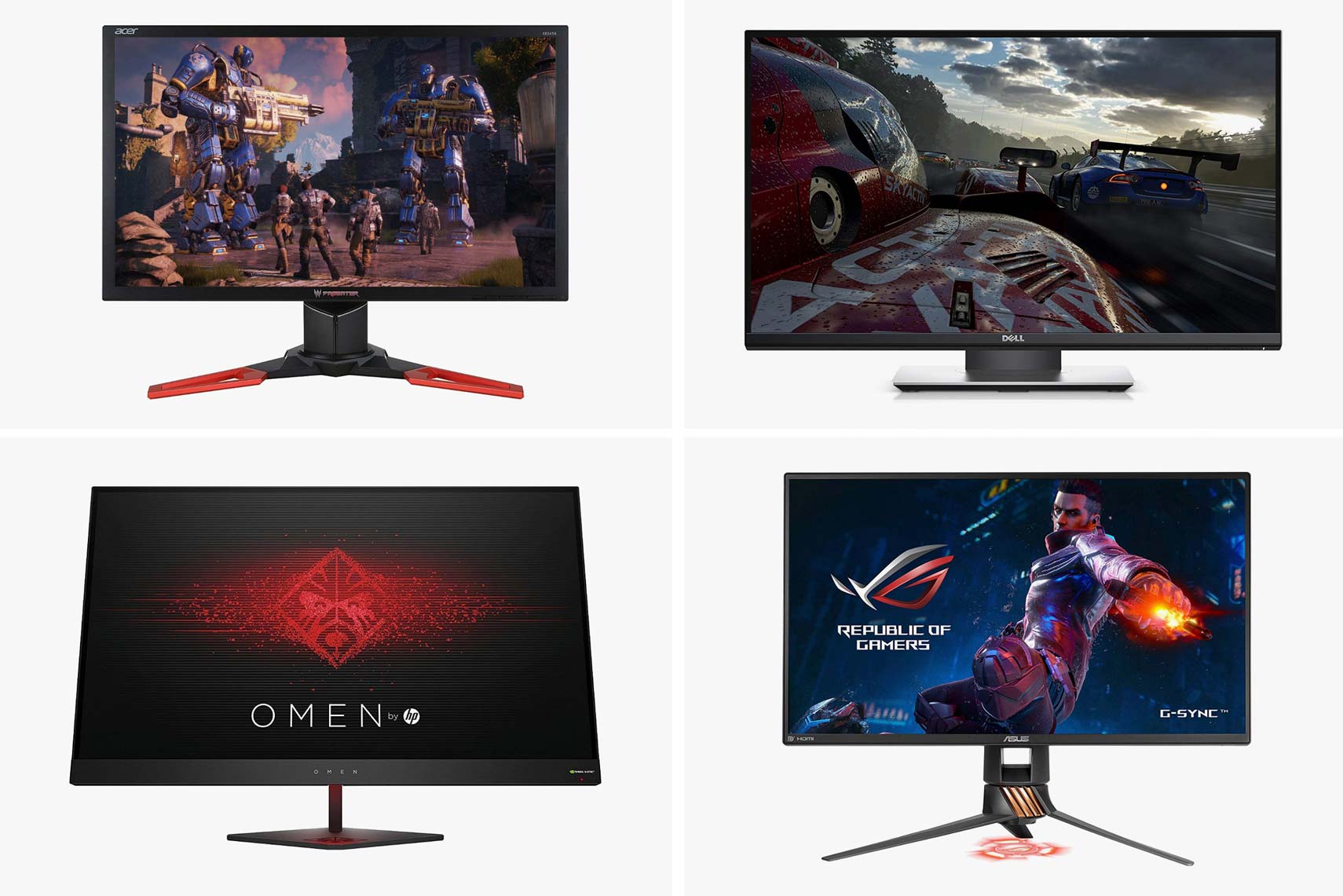We understand if you are having a lot of trouble shopping for the best G-Sync monitors. After all, there are dozens of options to choose from, with many models appearing to be identical to each other based on their technical specifications alone.
We’ll make things easier for you. In this guide, we have compiled the top 10 G-Sync monitors currently out on the market, from curved ultrawide monitors to 4K monitors. All products included here offer a premium gaming experience, with low input lag and fast response times.
One of the few budget-friendly G-Sync monitors on the market, the Acer Predator XB241H is a 24-inch display built specifically for serious gaming, featuring a 144 Hz native refresh rate, which can be overclocked to 180 Hz. It sells for $350, which is big news for those who don’t want to spend too much. If you mostly play fast-paced first-person shooter games such as Overwatch and Counter-Strike: Global Offensive, you’ll love this Acer display. It has an extremely fast response time and a low input lag, which is important in those games. Moreover, the 1080p resolution is easier on your graphics card while the 24-inch panel allows you to easily the entire screen. For single-player games with pretty visuals, this monitor is not recommended, mainly because it has a TN panel, a panel technology not exactly known for its picture quality. While the XB241H is better than most cheap TN monitors, the picture quality is subpar overall, with poor viewing angles and low contrast. On the bright side, the monitor has good peak brightness, which, combined with the anti-glare screen coating, allows the monitor to work well in a bright room. Overall, the XB241H is a solid option if you care more about gaming performance than picture quality. You may also be interested in some of the best console gaming monitors from our list. Check them out.
Aside from office monitors, Dell also offers gaming monitors, from curved ultrawide models to budget models, and one of the best in the lineup is the S2417DG. Selling for around $350-400, the S2417DG is similar to the Acer Predator XB241H. It has a TN panel, a 144 Hz refresh rate, and extremely fast response times, all of which point to it being a suitable monitor for competitive gaming. A 24-inch display, this Dell monitor looks more like an office monitor than a gaming monitor, featuring the same minimalist design as Dell office monitors, with the only notable difference being the glossy black back panel. Unlike with the Dell Alienware AW3418DW, there is no fancy lighting system on this monitor. The stand, which has integrated cable management, has good ergonomics, offering full adjustment options. The S2417DG, which has a QHD resolution, is best used for fast-paced competitive games where response times, refresh rates, and input lag matter more than picture quality. Since it has a TN panel, the overall picture quality is not that great, with limited viewing angles and mediocre contrast. Sure, the color accuracy is good once the monitor is calibrated, but if you want a display more suitable for games such as Hellblade: Senua’s Sacrifice and Shadow of the Tomb Raider, go for one of the IPS monitors on this list instead.
The HP Omen 27 is basically a bigger version of the Dell S2417DG, featuring the same panel type, the exact same 144 Hz refresh rate, and the same resolution. The most notable difference between the two is the screen size, with the Omen 27, as the model name suggests, offering a larger 27-inch screen. In terms of pricing, this HP unit is around $100 more expensive than the Dell unit. Regarding design, the Omen 27 is not as good as the Dell S2417DG, but only because it has worse ergonomics, only offering height adjustment and tilt. Considering the monitor has a TN panel, being able to easily adjust the screen position for better viewing angles is important. The Omen 27 has a good build quality and offers good color accuracy out of the box, which is a big plus for many people. Featuring extremely fast response times and a 165 Hz max refresh rate when overclocked, this HP unit is most suitable for competitive gaming. It has a low input lag, which is important in games in which being able to react on time is crucial. If you love to play first-person shooter games and fighting games, the Omen 27 is a recommended monitor for you. For some affordable options, check out our guide to the top cheap gaming monitors.
Some gamers are perfectly happy with a 144 Hz refresh rate. Others still find such a refresh rate disappointing and want something higher. If you want extremely high refresh rates, get the Asus ROG Swift PG258Q, which features a 240 Hz refresh rate. It sells for more than $500, a steep asking price for a TN monitor with a common 1920×1080 resolution. Compared to the Dell and HP monitors above, this 25-inch Asus display has a more stylish design, featuring a lighting system than fires down from the bottom of the stand and a circuitry aesthetic on the back panel. The stand, which has three legs, offers full adjustment options, which is great considering the viewing angle issues of TN panels. The PG258Q is an outstanding monitor for fast-paced competitive games such as Counter-Strike: Global Offensive and Overwatch, with the 240 Hz refresh rate allowing for impeccably smooth gaming. It has a very low input lag, which is important in competitive gaming. However, keep in mind that this monitor is best paired with a graphics card that can also consistently push out 200+ frames per second. If you are all about competitive gaming, the PG258Q is for you. If you have a more balanced gaming diet, there are better options on the market – such as the next item on this list. You will find more amazing display options by checking out our selection of the top-rated 1080p monitors. The Asus ROG Swift PG279QZ is an excellent all-around monitor that works well for gaming, office work, and general use. It has an IPS panel with a 2560×1440 resolution and a 144 Hz refresh rate, which can be easily overclocked to 165 Hz. Selling around $600, this Asus monitor is a more rounded unit than the PG258Q, which is great if you play both fast-paced competitive games and single-player games like Shadow of the Tomb Raider and Nier: Automata. A 27-inch display with a 16:9 aspect ratio, the PG279QZ has a well-designed chassis, with narrow bezels at the top and sides and well-secured connection ports at the back. It comes with a sturdy stand that supports the monitor well and offers full adjustment options. You can set it up easily, with the monitor featuring good out-of-box color accuracy, which can’t be said for a lot of monitors out there. Regarding overall performance, this gaming monitor is fantastic. It has a fast response time – which is notable considering response times are not the specialty of IPS panels – and a low input lag. With the high refresh rate and G-Sync support, smooth gaming is guaranteed with this monitor. The overall picture quality is also good, with wide viewing angles, good peak brightness, and great color accuracy, all of which make the PG279QZ a suitable monitor for both gaming and office use. If you are not a fan of both IPS and TN monitors due to their subpar contrast ratio, go for a VA monitor, which has significantly better contrast, perfect for games with a lot of dark scenes, such as survival horror games. However, compared to IPS and TN monitors, there are fewer G-Sync monitors that come with a VA panel. The LG 32GK850G-B is one of the best options on the market, especially if you want a screen with a standard 16:9 aspect ratio. It has a 32-inch screen with a QHD resolution and a 144 Hz refresh rate, which can be overclocked to 165 Hz. In contrast to the minimalist profile of most other LG monitors, the 32GK850G-B has an attractive design, featuring a cool lighting system on the back panel. It comes with a fully adjustable stand, though the adjustment ranges are not that great. Whether you play first-person shooter games or action RPGs, this LG unit will make for an excellent display. It has a low input lag and a fast response time, the latter of which is notable considering VA panels usually have the slowest response times out of the three panel types. Compared to TN monitors, the 32GK850G-B has much better picture quality, with better contrast and color reproduction, which makes it a more all-around monitor for different kinds of games. Our guide to the best-selling monitors for PS4 offers more great products for gamers. If you mostly play single-player games with lovely visuals, the Acer Predator XB271HK is a great option, featuring an IPS panel with a 3840×2160 (4K UHD) resolution for more detailed images. It has a 27-inch screen and a standard 60 Hz refresh rate, which is the most common refresh rate seen in 4K monitors. If you want something bigger, Acer also offers a 32-inch variant, which is more expensive, selling for around $150 more. Although the XB271HK is under the gaming-focused Predator brand, it has a plain design that won’t stick out even when used in an office setting. It comes with a fully adjustable stand that supports the monitor well, with no alarming wobbling issues. The stand, which has red-accented feet, offers cable management in the form of a hole in the bottom area. Like the Asus ROG Swift PG279QZ, this Acer 4K display is a well-rounded monitor that works well for both gaming and productivity. It’s great for games such as Far Cry 5, Hitman, and Monster Hunter: World, with the 4K resolution allowing for more detailed images. It has a fast response time and a good input lag even when running in 4K resolution. If you want an all-around G-Sync monitor with a 4K resolution and good gaming performance, get this Acer product. The Acer Predator Z35P is another great option if you want a VA monitor that supports G-Sync for smoother, screen-tear-free gaming. Unlike the LG VA monitor above, this Acer product is a curved ultrawide monitor with a curve radius of 1800R, which translates to a more aggressive curvature. It has a 35-inch panel with a 3440×1440 resolution and a standard 100 Hz refresh rate. Compared to the Acer Predator XB271HK, this particular model looks more like a gaming monitor, with the well-built chassis featuring red accents in several areas. The monitor has a significantly thicker frame than flat monitors, which means it will stick out more when mounted on the wall. The video input ports are down-facing at the rear while the USB ports are outward-facing on the left side of the back panel, which makes them easier to access than the inputs. The Z35P is a superb monitor for gaming, especially if you love to play racing games, flight simulators, open-world action RPGs, and survival horror games. It has a fast response time for a VA monitor and a good input lag regardless of the resolution. In addition, the curved ultrawide screen adds more immersion, which is especially beneficial in racing games and flight simulators. Overall, the Z35P is one of the best G-Sync monitors on the market, offering good gaming performance and good picture quality, with excellent contrast and great color accuracy. If you want a curved ultrawide monitor with G-Sync support but prefer a monitor with an IPS panel instead of VA, check out the Dell Alienware AW3418DW, which is in the same price range as the Acer Predator Z35P. It has the exact same resolution (3440×1440) and standard refresh rate (100 Hz), with the refresh rate also capping out at 120 Hz when overclocked. A 34-inch display, the AW3418DW has a significantly more stylish design than the Dell S2417DG, featuring a futuristic aesthetic – a common trend among Alienware products – complete with a multi-zone lighting system. It has narrow bezels at the top and sides and comes with a fancy stand that takes up a lot of desk space. Whether you love to play first-person shooters, racing games, or action RPGs, the AW3418DW will make for a great gaming monitor. The response time is fast while the input lag is low with or without G-Sync. Like the Acer Predator Z35P, this Dell monitor has a sharp curve radius (1900R), which makes gaming and watching movies more immersive. You can also use this monitor for productivity, with the large ultrawide screen allowing for easy multitasking. If you want an all-around ultrawide monitor that supports G-Sync and can spend around $900 on one, the AW3418DW is one of the best options. If you are interested in touch-screen displays, you will like some of the most popular touchscreen monitors from our list. One of the G-Sync Ultimate monitors currently out, the Asus ROG Swift PG27UQ is the best G-Sync monitor that you can get if money is not an issue for you. It sells for around $1,800, which is more than double the price of the second-most expensive item on this list. Featuring a 4K resolution and a max refresh of 144 Hz when overclocked, this Asus product is an all-around machine that works great for gaming, productivity, and watching movies. A 27-inch IPS display, the PG27UQ comes in a stylish casing, featuring a futuristic design with circuitry etches on the back panel and a cool lighting system. The stand, which offers full adjustment options and cable management, is also a head-turner. But the PG27UQ isn’t just about aesthetics and looking pretty; it also offers great picture quality and gaming performance. The PG27UQ is an excellent gaming monitor, featuring a fast response time and a good input lag even when the monitor is running in 4K or when HDR mode is enabled. And speaking of which, this unit is one of the few monitors that offer good HDR implementation. The PG27UQ is a DisplayHDR 1000 monitor – the highest level in the HDR standard created by the Video Electronics Standards Association (VESA) – featuring an extremely high peak brightness in HDR mode and wide color gamut support. In addition to being a top-notch gaming display, this Asus product is also suitable for productivity and general use. The overall picture quality is good, with wide viewing angles, good peak brightness in standard mode, and superb color accuracy. You can use it for photo editing, web development, graphics design, CAD software, and coding, among other things. If you want the best of the best – and money is not an issue for you – go for the PG27UQ. If, however, you prefer a monitor with subtler design, check out the similarly priced Acer Predator X27 instead. One of the best 4K monitors, the X27 offers the same features as the PG27UQ, so you are not going to miss out on anything significant if you go for the Acer monitor. 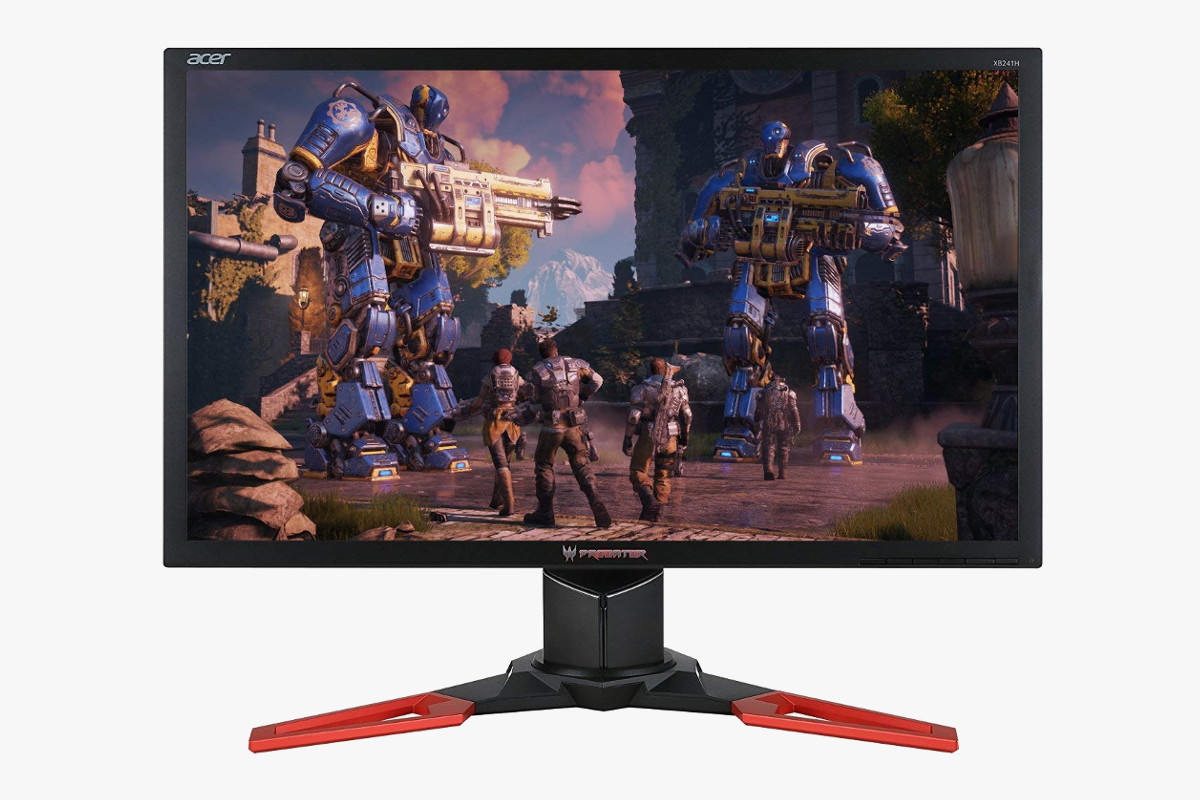 Acer Predator XB241H
Acer Predator XB241H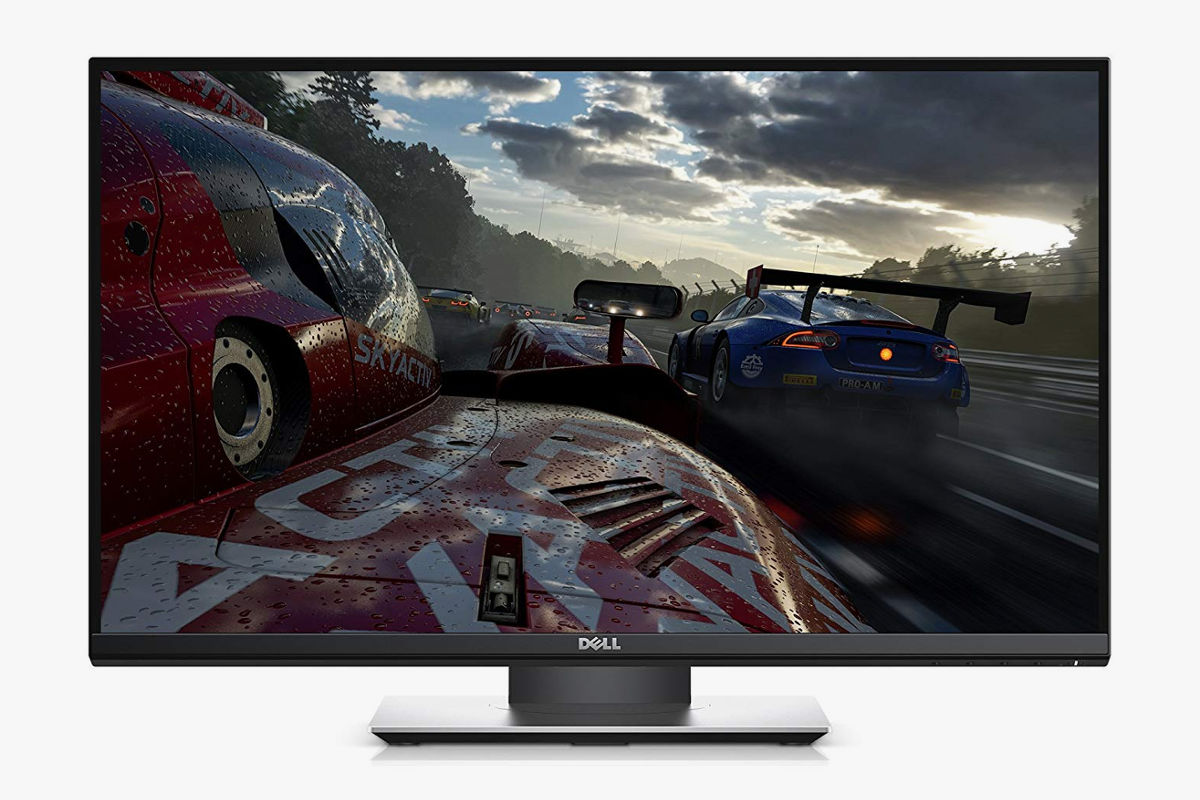 Dell S2417DG
Dell S2417DG
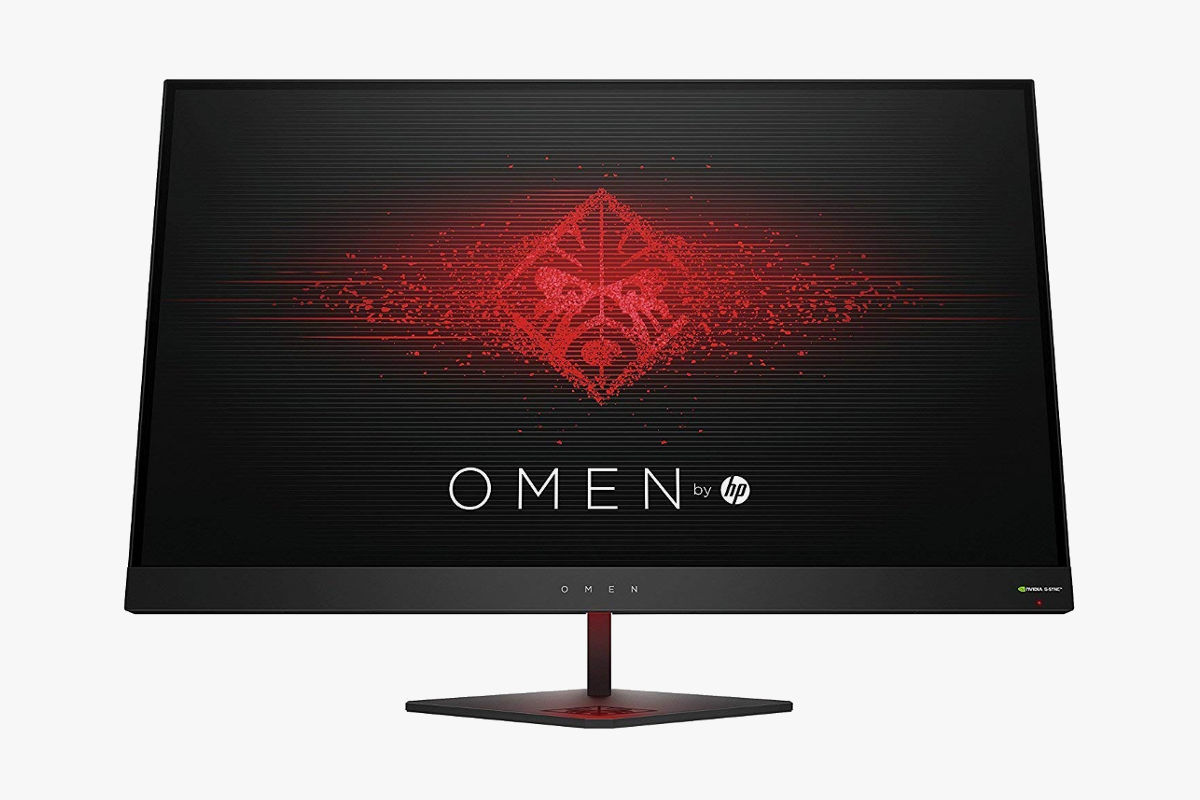 HP Omen 27
HP Omen 27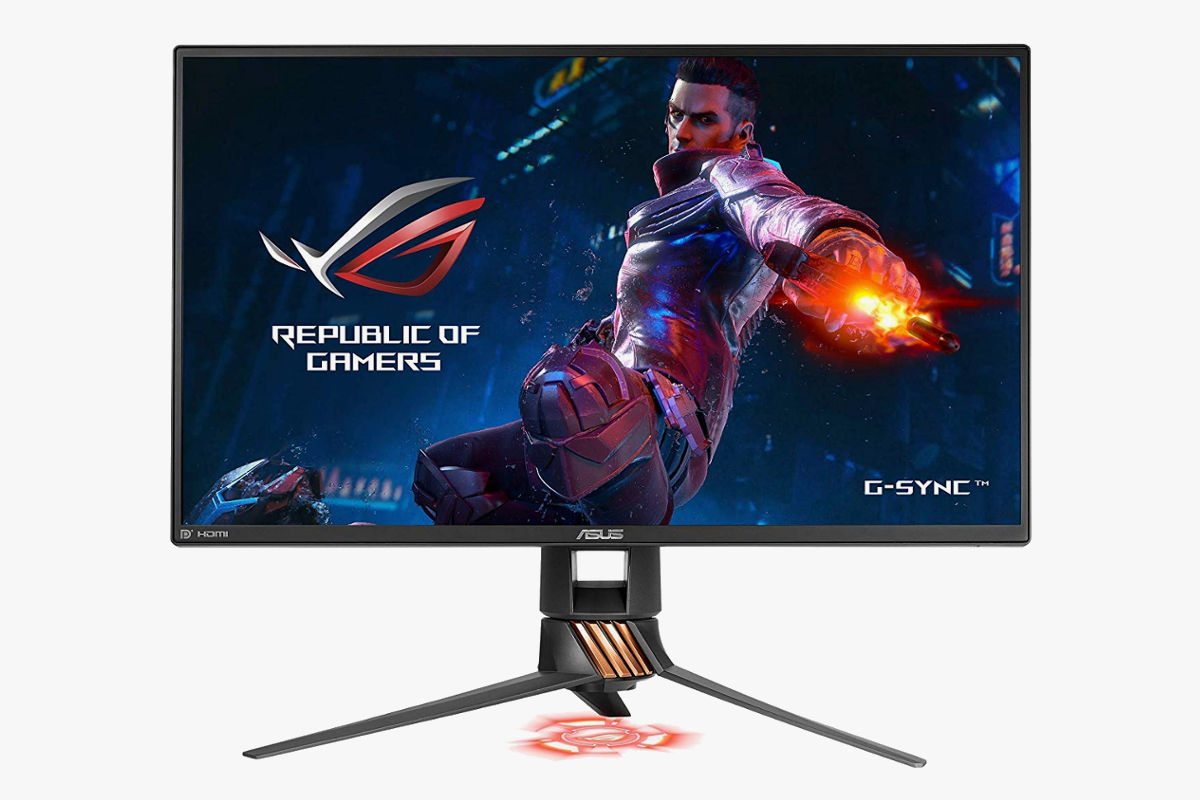 Asus ROG Swift PG258Q
Asus ROG Swift PG258Q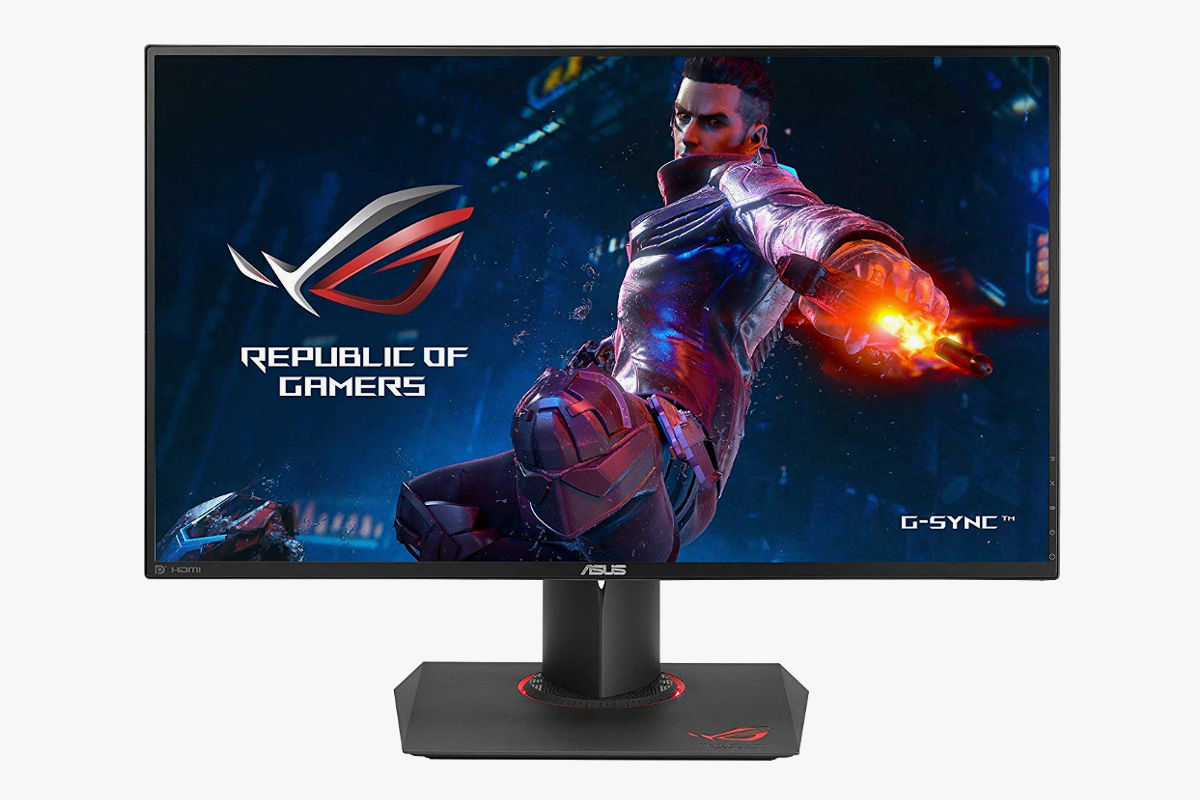 Asus ROG Swift PG279QZ
Asus ROG Swift PG279QZ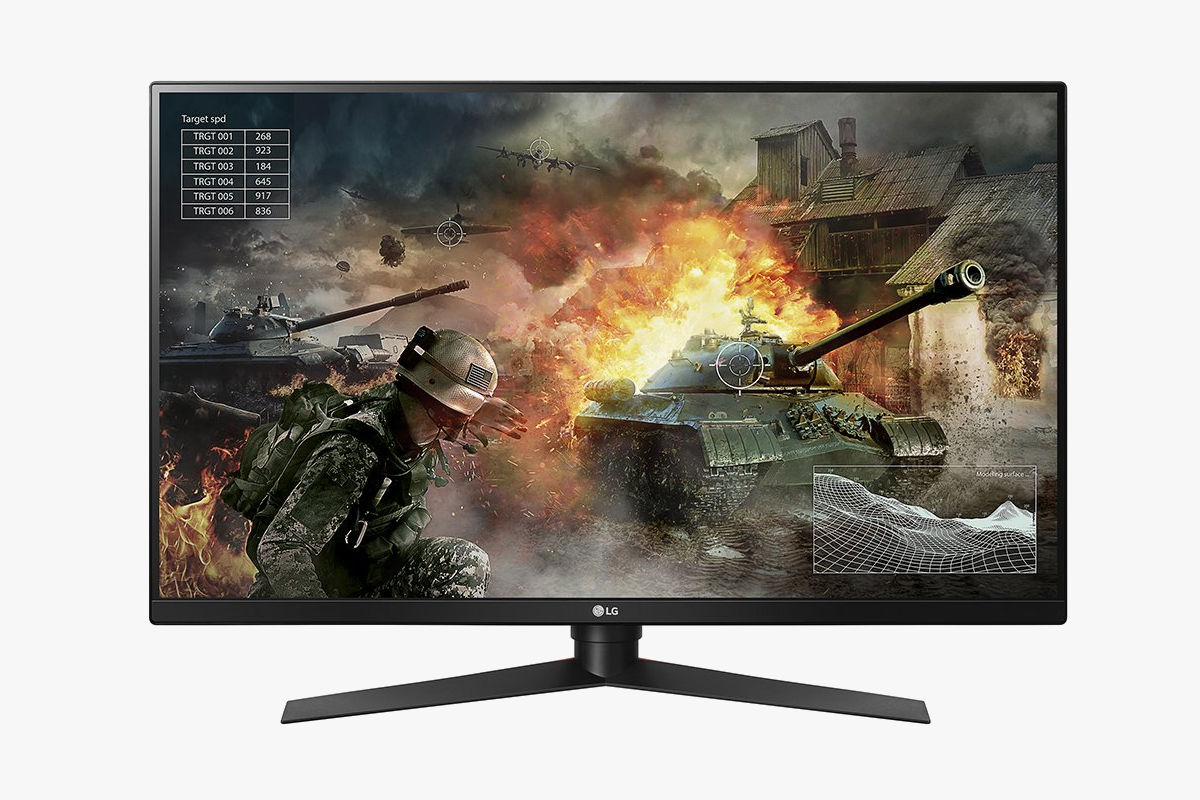 LG 32GK850G-B
LG 32GK850G-B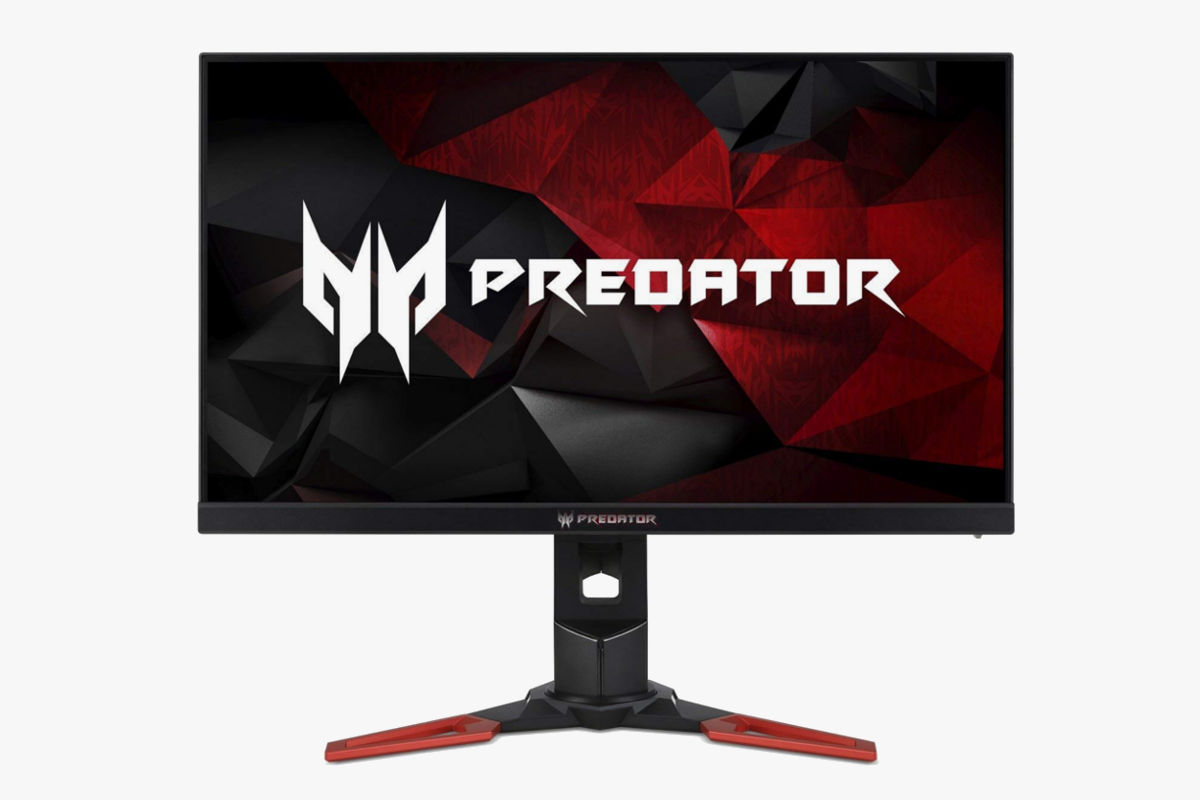 Acer Predator XB271HK
Acer Predator XB271HK Acer Predator Z35P
Acer Predator Z35P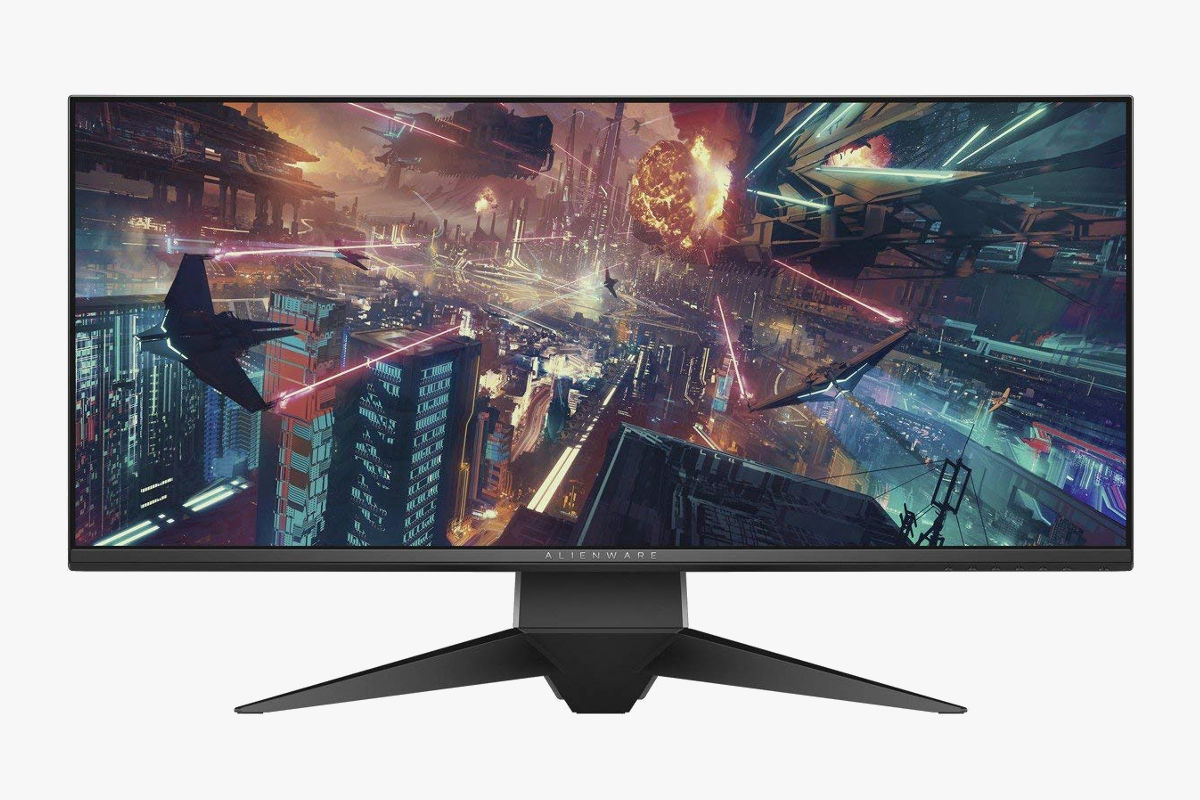 Dell Alienware AW3418DW
Dell Alienware AW3418DW
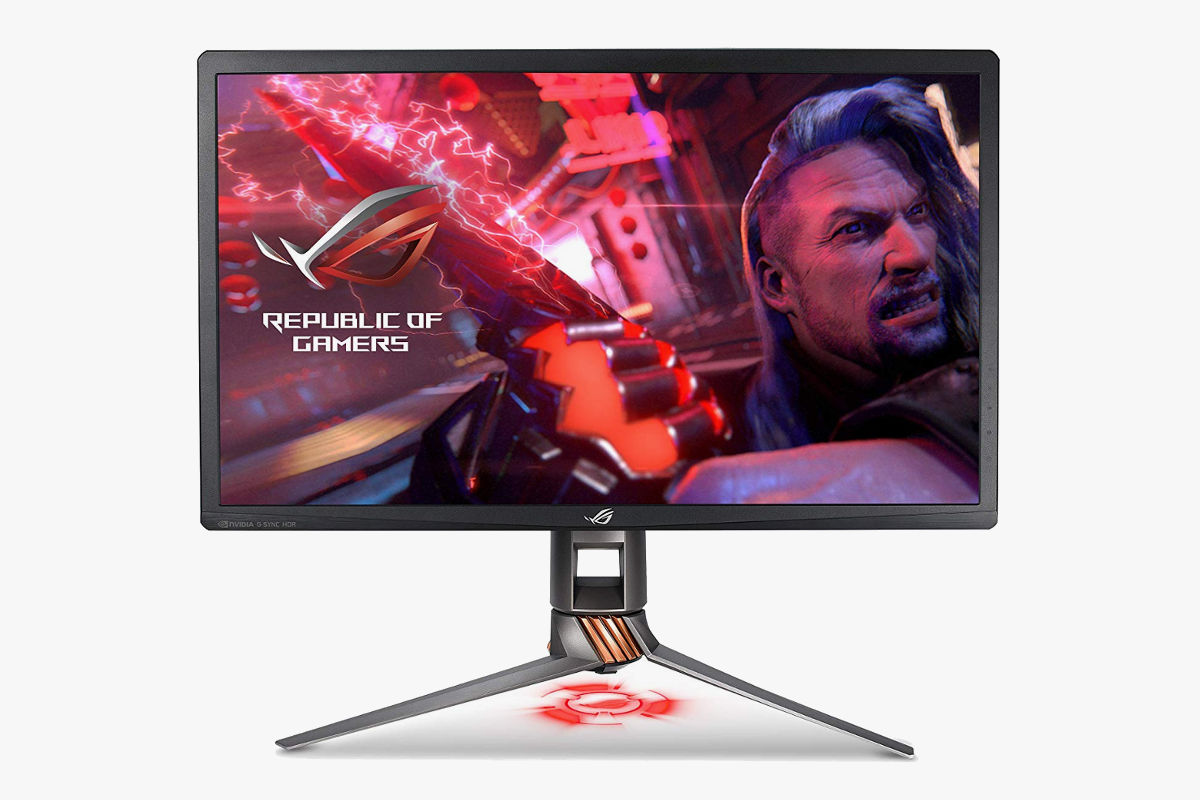 Asus ROG Swift PG27UQ
Asus ROG Swift PG27UQ
What is G-Sync?
Developed by Nvidia, G-Sync is an adaptive synchronization technology allowing for variable refresh rates in monitors. When the feature is enabled, a monitor (which typically has a fixed refresh rate) dynamically adapts to the graphics card (which has a variable output). For example, if the GPU is pushing out 53 frames per second, G-Sync will change the monitor refresh rate to 53 Hz. When the GPU output drops to 45 frames per second, the monitor will also drop to 45 Hz.
This eliminates the visual artifact known as “screen tearing,” which is when the monitor is displaying multiple frames at the same time with ugly horizontal lines or “tears” across the screen. And unlike Vertical Synchronization (VSync) technology – which does the opposite, adapting the GPU output to the monitor refresh rate – G-Sync has no negative impact on input lag, which is a big plus in fast-paced competitive games where input lag is crucial.
G-Sync is most beneficial when playing graphically intensive games at max settings, most especially if the resolution is 2560×1440 (QHD) or 3840×2160 (4K UHD). When playing those games at very high settings, the graphics card will be under a lot of pressure, which results in an erratic output. G-Sync keeps everything smooth when that happens, adapting the display refresh rate to the graphics card output in real-time.
G-Sync vs. FreeSync
Although AMD FreeSync functions the same way as G-Sync, the two technologies are not completely the same regarding their implementation. In some areas, the former is better while in some areas the latter has the edge.
Compared to FreeSync, G-Sync offers more stable and consistent performance, especially concerning input lag and effective range. This is due to Nvidia being stricter when it comes to the implementation of its technology, requiring that all G-Sync monitors meet the company’s high standards.
All G-Sync monitors feature a low input lag and a wide effective range, with the range typically starting from 30 Hz up to the monitor’s max refresh rate. For instance, if the monitor’s max refresh rate is 144 Hz, the range is 30-144 Hz. FreeSync, on the other hand, is less consistent since monitor manufacturers have more freedom in how the technology is implemented. For example, two FreeSync monitors with the same max refresh rate may have different ranges.
G-Sync requires proprietary hardware sold by Nvidia to be installed in a monitor. This explains the big price difference between G-Sync monitors and regular/FreeSync monitors. Some of the best products on the market sell for over $700, which is not an accessible price range for many people. In addition, G-Sync monitors are fewer in number compared to FreeSync monitors, with many of the products coming from Acer and Asus and not much representation from other notable brands such as ViewSonic and BenQ.
Lastly, G-Sync only works with Nvidia graphics cards, starting from the GeForce GTX 650 Ti Boost up to the latest models, and only when using a DisplayPort cable. If you connect a G-Sync monitor to an AMD graphics card, it will simply function as a regular monitor. On the other hand, some FreeSync monitors now allow for variable refresh rates when connected to GeForce GTX 10-Series and RTX 20-Series graphics cards.
G-Sync Ultimate and G-Sync Compatible Monitors
Originally called G-Sync HDR, G-Sync Ultimate is basically G-Sync with high dynamic range (HDR), which allows for more vibrant images with better contrast and more colors. Unlike HDR monitors selling for less than $1,000, G-Sync Ultimate monitors – which are ridiculously expensive – offer proper HDR support, featuring extremely high peak brightness and wide color gamut support. There aren’t many G-Sync Ultimate monitors currently out on the market, though, with the Acer Predator X27 and the Asus ROG Swift PG27UQ being the most notable ones.
While we didn’t specifically use their proper name, we already mentioned G-Sync Compatible monitors in the previous section. Announced at CES 2019, G-Sync Compatible monitors are simply FreeSync monitors that allow for variable refresh rates when connected to certain Nvidia graphics cards, but only when connected via DisplayPort and with the required driver installed.
Although they don’t offer the same premium gaming experience as true G-Sync monitors, G-Sync Compatible monitors are a lot more affordable, with some models selling for less than $200. This is big news for those who own an Nvidia GPU and can’t afford to buy G-Sync monitors. We did not include G-Sync Compatible monitors in this guide, though, because they are basically FreeSync monitors and are not in the same category as real G-Sync monitors.
Conclusion
While G-Sync monitors sound like a total dream for gaming, they are not for everyone. Some find them an essential ingredient while others don’t really care about screen tearing – and that’s assuming they can easily spot screen tearing in games – and therefore don’t find value in G-Sync monitors. One of the easiest ways to check if G-Sync monitors will prove to be beneficial for you is to consider your PC setup and what kinds of games you usually play.
If you regularly experience significant frame rate drops when running games at max or near-max settings, especially in games with pretty visuals, then G-Sync monitors are for you. The same thing can be said if you find screen tearing repulsive or want a futureproof setup since future games are likely going to be more graphically intensive.
On the other hand, if you don’t care about screen tearing or mostly play fast-paced competitive games at regular settings or own an extremely powerful gaming rig that can easily keep up with monitors with a high refresh rate, then G-Sync will not be all that beneficial for you.
